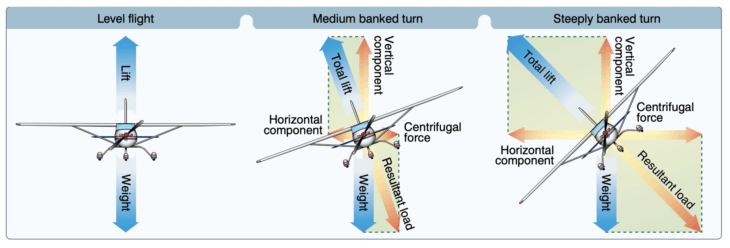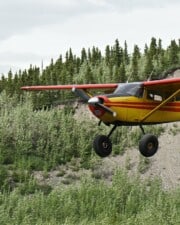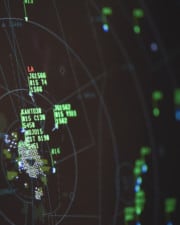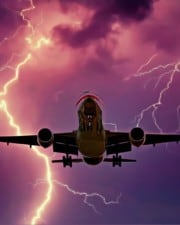Flying involves moving the aircraft in three dimensions, which makes turning it significantly more involved than turning a car. To turn a plane, the pilot uses all three primary flight controls to move the airplane around its three axes.
How Do Airplanes Turn?
To turn a plane, the pilot uses all three primary flight controls to move the airplane around its three axes. The airplane must be rolled into the turn, the nose yawed into it, and pitched up to maintain altitude.
While these are the pilot’s inputs to make it happen, the actual force that makes an airplane turn is called the horizontal component of lift. Just like vertical lift, it is generated by the wings. When the pilot banks the plane, the wings not only hold the plane aloft but also pull the plane into a turn.
The Flight Controls and Their Inputs
Successfully turning an airplane requires a bit of practice. The exact control forces will vary from plane to plane, so making turns at various bank angles is an important part of pilot training. As the bank angle increases, the aerodynamic factors going into the making the turn happen become more pronounced. The result is that it is relatively easy to make shallow banked turns, but steep turns require much more finesse.
The most important flight controls to make a turn happen are the ailerons. They are controlled in the cockpit with the control yoke or stick. When you move the wheel left or right, the ailerons move up and down on the wingtips. In a left turn, the right aileron goes down to make more lift on the outside wing, and the left aileron goes up to make less lift on the inside wing. The airplane then rolls to the left.

Pilots must also move the nose of the plane to the left to continue the turn. The plane will likely start turning once the ailerons are deflected, but to keep the turn smooth and coordinated, some left rudder is applied by depressing the left rudder pedal.
If the turn is steep enough, the plane will begin losing altitude. To hold their height above the ground, the pilot pitches up by pulling back on the control yoke. This deflects the elevator up, which keeps the nose up.
In very steep turns, the extra elevator pressure will slow the airplane down a little. To hold their airspeed, the pilot will need to add engine power to maintain their airspeed.
3 Types of Turns
Turns are divided into three categories–shallow, medium, and steep-banked turns. The airplane behaves slightly differently in each type of turn.
1. Shallow Banked Turns
Shallow turns are banks less than 20 degrees. These are the most common turns during flight. During this sort of turn, the planes designed stability will attempt to bring the wings level again. Once the pilot rolls into a turn, they’ll have to keep making corrections to maintain the desired bank angle.
2. Medium Banked Turns
Medium banked turns are between 20 and 45 degrees. At these angles, the airplane’s stability does not return it to level flight, so it keeps a constant bank angle with little input from the pilot.
3. Steep Banked Turns
Steep turns are bank angles over 45 degrees. Here the airplane becomes less stable, and the forces acting on it will attempt to increase the bank angle. As a result, the pilot will have to make constant corrections to keep their desired bank angle constant.
Constant Rate Turns
In instrument flying, controlling the turn rate is more important than controlling the bank angle. Imagine being an air traffic controller, trying to tell a pilot when to start their turn, so that they can intercept the course to a runway. If the pilot can turn at any rate they want to, then the job is impossible. There must be a standard rate of turn that the pilot makes, and that the controller can expect.
Luckily, there is. A standard rate turn is one that takes two minutes to complete a 360-degree turn. In the cockpit, it is shown by the turn coordinator, which is calibrated this way.
Without the turn coordinator to reference, the rate of turn must be calculated. The faster an airplane flies, the larger the radius of the turn will be, and the slower its rate of turn will be for a given bank angle. Therefore, to make a standard rate turn, you must increase your bank angle as airspeed increases. Instrument pilots practice timed turns so they can calibrate their instrument, and in case the turn coordinator ever fails during flight.
In the en-route environment, aircraft are flying at very high speeds. There’s no reason to make steep turns at these altitudes, so pilots generally make half standard rate (four-minute) turns.
Rudder Use to Maintain Coordinated Flight
The rudder’s purpose is to counteract the adverse yaw created by the ailerons. This yaw is caused by the increased induced drag on the outside aileron. It can make the plane’s rate of turn less than it should be for the amount of bank angle.
Slips and Skids
To keep the turn rate appropriate, the pilot can use more or less rudder going into a turn. This is known as making a coordinated turn. A turn with too high a turn rate is known as a slip, while a turn with too little turn rate is a skid.
The Turn Coordinator
In the cockpit, an instrument known as the turn coordinator helps. The instrument face includes a simple floating ball known as a slip-skid indicator. The ball is pulled into or away from the turn, depending on the forces acting on it. Pilots learn to “step on the ball,” which means that if the ball isn’t centered, they need to apply more rudder pressure.
You may have heard the saying, “Flying by the seat of your pants.” While this has come to mean flying on skill alone, in flight training, it means learning to feel the pressure exerted on your body inside the plane. Experienced pilots don’t even need to look at the ball–they can feel the forces acting on the plane.
Aerodynamics of a Turn
The pilot moves the controls, which move control surfaces on the wings and tail. This changes the airplane’s orientation in the air and points it in the right direction. But what actually makes an airplane turn?
Once the airplane is banked, the wings continue to produce lift perpendicular to the wingspan of the plane. Since the wings are now banked into the turn, some of the lift is pointed up (opposite gravity), and some is pointed into the turn. This horizontal component of lift is what makes the airplane turn.

Accelerated Stalls
It’s important to remember that due to the increased load factor during turns, the stall speed increases as the bank angle increases. This phenomenon is known as an accelerated stall.
The stall speed shown on the airspeed indicator is for straight and level, unaccelerated flight. Once the airplane banks, the stall speed goes up. A pilot should always be at a safe airspeed before beginning any maneuvers, especially steep turns.
Most pilots limit their turns at slow speeds and near the ground to 30-degree bank turns. This limit is especially critical in the traffic pattern after takeoff and before landing.
Related Posts














